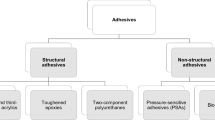Abstract
The use of adhesive studs is gaining an importance as a method for assembly and mounting options as part of the trend towards multi-material design. For the efficient implementation of this technique, it is crucial that a reproducible and—above all—fast manufacturing process can be guaranteed. The use of radiation-cured adhesive provides a good solution. In context of a research project, which was performed at the Laboratory of Material and Joining Technology at the University of Paderborn, adhesives studs are characterized in terms of application-specific requirements, e.g., behavior under different loads or the combination with environmental influences or process time. The results that were achieved through the research show the potential of adhesive studs for assembly applications. The mechanical properties meet the requirements of a wide range of mounting options. Total cycle times under 10 seconds provide the basis for adhesive studs to be a real competitor to the established mechanical and thermal joining technologies.










Similar content being viewed by others
References
Meschut G, Süllentrop S (2012) Eigenschaftsprofil Klebbolzen, 12. Kolloquium Gemeinsame Forschung in der Klebtechnik, DECHEMA, Frankfurt, 29. Februar 2012
Meschut G, Süllentrop S, Drüke F (2012) “Adhesive studs based on radiation-cured adhesives”, Joining in Car Body Engineering 2012—adhesive bonding and hybrid bonding, Automotive Circle International, Bad Nauheim, 17. April 2012
Hose R, Scholl B, Tobisch-Haupt R, Werner W (2007) BOND it—reference book on bonding technology, 2nd, revised and extended English edition, Delo, Windach
Wellmann S (2008) Superschnell und trotzdem zuverlässig, erschienen in: Adhäsion - Kleben & Dichten, 12/2008, S. 31–34
Becker HG (1991) (Hrsg.): Einführung in die Photochemie, 3. bearb. Aufla-ge, Dt. Verlag der Wissenschaft, Berlin
Crivello JV, Dietliker K (1998) Photoinitiators for Free Radical Cationic & Anionic Photopolymerisation, 2nd edn. Wiley, London
Foussier JP, Allonas X, Burget D (2003) Photopolymerization reactions under visible lights—principle, mechanisms and examples of applications, erschienen in: Progress in organic coatings, 47/2003, S. 16–36
(2010) N.N.: Bestimmung des Kohlenstoff-Doppelbindungsgehaltes von lichthärtenden Acrylat-Klebstoffen mittels IR-Spektroskopie, DELO Prüfnorm 43, DELO Industrieklebstoffe, Windach
Acknowledgments
The IGF project 16.778 N (DVS: 08.071) of the research association Schweißen und verwandte Verfahren e.V. of the DVS, Aachener Str. 172, 40223 Düsseldorf was funded by the AiF under the program for the promotion of joint industrial research and development (IGF) by the Federal Ministry of Economics and Technology based on a decision of the German Bundestag. We also thank the members of the project support committee for their organizational and financial support.
Author information
Authors and Affiliations
Corresponding author
Additional information
Doc. IIW-2491, recommended for publication by Commission XVI “Polymer Joining and Adhesive Technology.”
Rights and permissions
About this article
Cite this article
Meschut, G., Süllentrop, S. The use of radiation-cured adhesives on adhesive stud assembly process. Weld World 58, 755–762 (2014). https://doi.org/10.1007/s40194-014-0176-1
Received:
Accepted:
Published:
Issue Date:
DOI: https://doi.org/10.1007/s40194-014-0176-1




